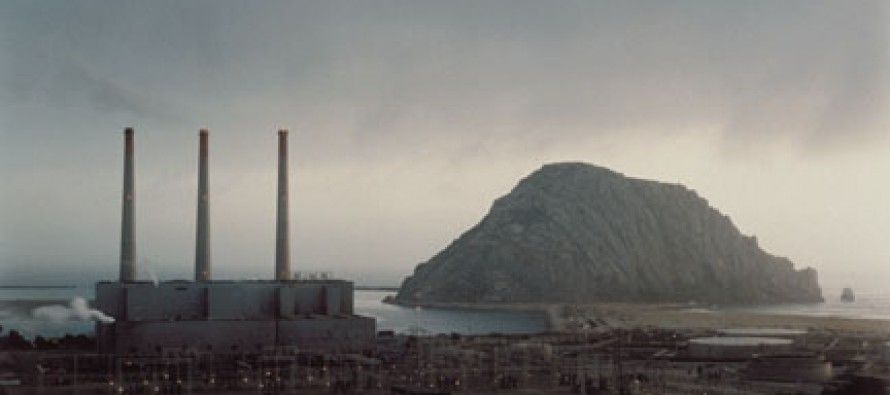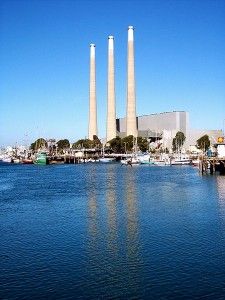Morro Bay Power Plant shutdown saves fish, kills birds

 Power plants keep closing in California. Earlier this year, Southern California Edison announced it permanently would shut down its San Onofre Nuclear Generating Station.
Power plants keep closing in California. Earlier this year, Southern California Edison announced it permanently would shut down its San Onofre Nuclear Generating Station.
Then Dynergy Energy announced last month it would decommission the Morro Bay Power Plant whose three tall smokestacks for 50 years have become almost as big a symbol of the city as its looming Morro Rock.
The plant is one of 19 gas-fired power plants along the coast of California, comprising 5,500 megawatts of power generation to be phased out of operation to protect marine life (see map here). The City of Morro Bay has proposed to permit a commercial and tourist redevelopment project on the power plant site.
The major reason for mothballing the power plant was its negative impact on marine life. Thousands of fish larvae got sucked into the power plant’s ocean water inlet. However, mature fish could not get pulled into the inlet because each inlet tube is only 3/8-inch wide.
Moreover, as in George Orwell’s “Animal Farm,” in California some animals are more equal — and valuable — than others. In line with the new priorities of renewable energy, fish seem to be more “equal” than birds and turtles.
For example, there were 34 reported bird deaths in Sept. 2013 attributed to BrightSource Energy’s 459-foot high tower that beams sunlight to thousands of surrounding mirrors at its Ivanpah solar energy project. Also threatened there: 2,325 juvenile desert tortoises.
But unlike fish on the scenic coast, the Ivanpah project is out of sight and mind, located 50 miles from the Salton Sea in the Mojave Desert.
No government agency has ordered an equivalent shutdown of the Ivanpah solar power plant.
Morro Bay Power Plant replaced by CA Valley Solar Ranch
Morro Bay is now getting power from the new California Valley Solar Ranch in eastern San Luis Obispo County. This $1.6 billion, 250-megawatt solar farm comprises 749,088 solar panels covering 1,500 acres. Which means it costs an astronomical $6,400,000 per installed megawatt of energy, operating at a capacity factor of 22 percent.
By contrast, a natural gas-fired power plant, such as Morro Bay’s, would require one-fourth of the capital investment; would cost about $1,000 per megawatt installed; would be making four times the electricity at an 88 percent capacity factor; and would impact about 25 acres of land. The California Solar Farm project is not economically feasible without large government tax credits.
It is estimated the power from California Valley Solar Ranch will cost ratepayers from $0.15 to $0.18 per kilowatt-hour. PG&E’s baseline electricity rate is $0.11 per kilowatt hour.
Starwood
Another option being considered by the city is to partner with Starwood Energy Group, based in Connecticut, to generate clean, renewable energy at the power-plant site.
Starwood’s Chairman is Barry S. Sternlicht, a registered voter in the Democratic Party. He also has been a prominent fund raiser and organizer for President Obama, former Secretary of State Hillary Clinton, Senate Majority Leader Harry Reid, former Vice President Al Gore, Former President George W. Bush and others.
Ironically, in 2009 Starwood already planned on building a large concentrating solar energy tower plant in Arizona like the Ivanpah solar plant in California. But the idea for the project ended up being abandoned. According to Reuters, “Lockheed Martin Corp was the engineering, procurement and construction firm for the Starwood project. [Arizona Public Services] said Lockheed Martin decided not to go forward with the project due to the size and the final risk profile of the EPC contract, among other factors.”
This begs the question: If a solar farm were constructed on the site of the old Morro Bay Power Plant, would environmentalists try to shut it down for killing birds, not fish?
Related Articles
How rich: CTA parent group struggles with pension costs
The following news nugget almost has an Onion feel to it, it’s such a perfect commentary on the aggressively dishonest
Races to decide California Democrat Supermajority
Nationally, Republicans have already taken the majority in the United States Senate and now the question is whether the Republican
Los Angeles County plagued by local corruption
California doesn’t have nearly the reputation of, say, New Jersey or Maryland when it comes to a history of public




